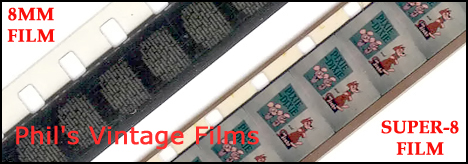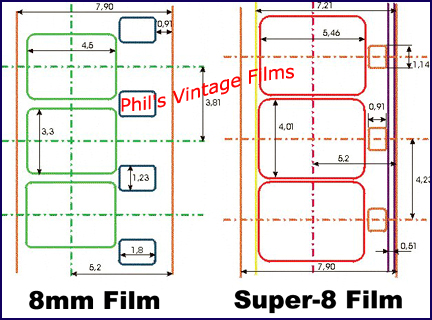
Phil's Vintage 8mm, Super-8 and 16mm
Films and Projectors
8mm - super-8 - 16mm
film
VINTAGE
CLASSIC |
Updated
August 15, 2025 *** Note that older movies on television and almost all DVD's are now sped up by a degree of 5 to 10%. This makes movement of the image in most cases unnatural, and (to me anyway) unwatchable. It is especially bad when it is a movie or TV show you have seen many times before in the correct running speed. Soon the only way to see an older movie that is not corrupted is to watch Film or get the older VHS or Betamax tapes.*** All films are for private home viewing only. There are no public performance rights given. I do not have any unexposed film to use in movie cameras. * Please note that I cannot accept films returned because they can't run or are damaged because of your projector. All films are inspected, cleaned and are in excellent running condition when they are shipped to you. Please make sure you have a properly running projector and know how to use it. Thanks very much! *
Check out this
great page by Paul Ivester:
|
Many
of the films offered on the pages linked below are Like New or in Near Mint condition. As
such, especially with black and white film, they can be very dry. If they are not
lubricated, depending on your projector, they can not slip properly when going through the
gate and may clatter or the image may even jitter. All films, especially new condition or
green prints, need to be lubricated for optimum performance. On my LINKS page you
can go to URBANSKI FILM &
VIDEO to buy Filmrenew,
FILM-TECH or
AMAZON to buy FilmGuard to
clean and protect your prints. Dirt can build
up on the guide rails that can also cause this problem. You must always keep the film gate
and pressure pad of your projector clean and polished. I clean my film gates after every
few
reel runs. I saturate a Q-tip with FilmGuard to scrub off any hard dirt and
then polish it off with a soft cotton cloth. |
The Difference in 8mm and Super-8/Single-8 Film
Super 8mm film was introduced in 1965 as an improvement over regular 8mm, although 8mm film continued to be used even up to today. Super-8 film features smaller sprocket holes and a smaller space in between the frames. The result is a 50 percent larger frame area. The charts below show you the difference between 8mm and super-8 film.
(NOTE: Single-8 Film is simply the name Fuji gave to their polyester based super-8 film that was in a different style camera cartridge. Otherwise Single-8 film is the same as Super-8 and can be run on any super-8 projector.)
 |
|
 |
 |
Pick the film format you want below for links to other pages with lists of films exclusively in that format: |